XPhos Pd G3
Synonym(s):(2-Dicyclohexylphosphino-2′,4′,6′-triisopropyl-1,1′-biphenyl)[2-(2′-amino-1,1′-biphenyl)]palladium(II) methanesulfonate;XPhos-G3-Palladacycle;XPhos-Pd-G3
- CAS NO.:1445085-55-1
- Empirical Formula: C46H62NO3PPdS
- Molecular Weight: 846.46
- MDL number: MFCD22666043
- SAFETY DATA SHEET (SDS)
- Update Date: 2024-08-21 22:41:43

What is XPhos Pd G3?
The Uses of XPhos Pd G3
XPhos Pd G3 may be used in the following reactions:
- Cyanation reaction of heterocyclic halides.
- Coupling of heteroaryl chlorides with polyfluoroaryl zinc reagents.
- Coupling of 2,6-difluorophenylboronic acid with (hetero)aryl chlorides.
The Uses of XPhos Pd G3
Convenient dosable form of XPhos-Pd-G3.
0.025 mmoles per capsule (1EA = 0.025 mmoles)
General Description
XPhos Pd G3 is a third generation (G3) Buchwald precatalyst. It is air, moisture and thermally-stable and is highly soluble in a wide range of common organic solvents. It has long life in solutions. XPhos Pd G3 is an excellent reagent for Suzuki cross-coupling reactions. Some of its unique features include lower catalyst loadings, shorter reaction time, efficient formation of the active catalytic species and accurate control of ligand: palladium ratio.
Properties of XPhos Pd G3
| Melting point: | 146-151°C (decomposition) |
| storage temp. | under inert gas (nitrogen or Argon) at 2-8°C |
| form | Powder |
| color | white to off-white |
Safety information for XPhos Pd G3
| Signal word | Warning |
| Pictogram(s) |
 Exclamation Mark Irritant GHS07 |
| GHS Hazard Statements |
H315:Skin corrosion/irritation H319:Serious eye damage/eye irritation H335:Specific target organ toxicity, single exposure;Respiratory tract irritation |
| Precautionary Statement Codes |
P280:Wear protective gloves/protective clothing/eye protection/face protection. P302+P352:IF ON SKIN: wash with plenty of soap and water. P305+P351+P338:IF IN EYES: Rinse cautiously with water for several minutes. Remove contact lenses, if present and easy to do. Continuerinsing. |
Computed Descriptors for XPhos Pd G3
| InChIKey | VXKANHUGMZCOIM-UHFFFAOYSA-N |
| SMILES | P(C1CCCCC1)(C1CCCCC1)(C1C=CC=CC=1C1C(=CC(C(C)C)=CC=1C(C)C)C(C)C)[Pd+2]1(NC2=CC=CC=C2C2=CC=CC=[C-]12)[O-]S(=O)(=O)C |
XPhos Pd G3 manufacturer
Johnson Matthey Chemicals India Pvt Ltd
1Y
Phone:+91-9711869003
Whatsapp: +91-9711869003
product: 1445085-55-1 XPhos Pd G3 98%
New Products
(S)-3-Aminobutanenitrile hydrochloride 4-Methylphenylacetic acid N-Boc-D-alaninol N-BOC-D/L-ALANINOL Tert-butyl bis(2-chloroethyl)carbamate 3-Morpholino-1-(4-nitrophenyl)-5,6-dihydropyridin- 2(1H)-one Furan-2,5-Dicarboxylic Acid Tropic acid 1-Bromo-3,5-Di-Tert-Butylbenzene S-2-CHLORO PROPIONIC ACID ETHYL ISOCYANOACETATE 2-Bromo-1,3-Bis(Dimethylamino)Trimethinium Hexafluorophosphate 4-IODO BENZOIC ACID 3-NITRO-2-METHYL ANILINE 1-(2,4-DICHLOROPHENYL) ETHANAMINE (2-Hydroxyphenyl)acetonitrile 4-Bromopyrazole 2-(Cyanocyclohexyl)acetic acid 4-methoxy-3,5-dinitropyridine 1-(4-(aminomethyl)benzyl)urea hydrochloride 2-aminopropyl benzoate hydrochloride diethyl 2-(2-((tertbutoxycarbonyl)amino) ethyl)malonate tert-butyl 4- (ureidomethyl)benzylcarbamate Ethyl-2-chloro((4-methoxyphenyl)hydrazono)acetateRelated products of tetrahydrofuran








You may like
-
 1445085-55-1 XPhos Pd G3 98%View Details
1445085-55-1 XPhos Pd G3 98%View Details
1445085-55-1 -
 Methanesulfonato(2-dicyclohexylphosphino-2',4',6'-tri-i-propyl-1,1'-biphenyl)(2'-amino-1,1'-biphenyl-2-yl)palladium(ii) 98% CAS 1445085-55-1View Details
Methanesulfonato(2-dicyclohexylphosphino-2',4',6'-tri-i-propyl-1,1'-biphenyl)(2'-amino-1,1'-biphenyl-2-yl)palladium(ii) 98% CAS 1445085-55-1View Details
1445085-55-1 -
 XPhos Pd G3 CAS 1445085-55-1View Details
XPhos Pd G3 CAS 1445085-55-1View Details
1445085-55-1 -
 XPhos Pd G3 ChemBeads CAS 1445085-55-1View Details
XPhos Pd G3 ChemBeads CAS 1445085-55-1View Details
1445085-55-1 -
 1975-50-4 98%View Details
1975-50-4 98%View Details
1975-50-4 -
 2-HYDROXY BENZYL ALCOHOL 98%View Details
2-HYDROXY BENZYL ALCOHOL 98%View Details
90-01-7 -
 14714-50-2 (2-Hydroxyphenyl)acetonitrile 98+View Details
14714-50-2 (2-Hydroxyphenyl)acetonitrile 98+View Details
14714-50-2 -
 118753-70-1 98+View Details
118753-70-1 98+View Details
118753-70-1
Statement: All products displayed on this website are only used for non medical purposes such as industrial applications or scientific research, and cannot be used for clinical diagnosis or treatment of humans or animals. They are not medicinal or edible.